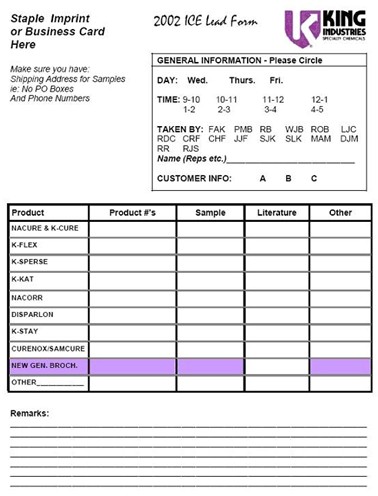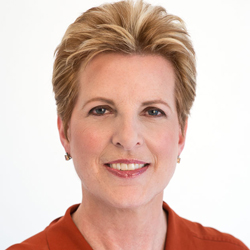In tradeshow marketing, it is tempting to boast about the busy buzz at your booth and how many leads you generated. But don't succumb to temptation. You would be so much better off if you paid attention to lead quality instead of quantity.
One secret to tradeshow success is your ability to qualify prospects on the tradeshow floor. Here's why:
- Not all visitors will ever be in a position to buy from you or refer you business. There is no point in spending time on unproductive conversations.
- Mere contact names are no more valuable than a mailing list. Contacts and inquiries must be converted to qualified leads before they will convert to sales revenue.
- If you don't qualify the contact on the tradeshow floor, you will have to invest in follow-up qualification after the event.
Setting Qualification Criteria
It is marketing's job to provide qualified leads to sales. Sales then works the leads until they convert to revenue—or are declared otherwise "closed." This division of labor increases the productivity of a highly skilled and expensive sales force by ensuring that salespeople spend the bulk of their time in front of qualified prospects.
But the system only works if...
- Sales and marketing agree on the definition of qualified.
- Marketing never, ever, hands an unqualified lead over to the sales force.
These rules hold true for contacts and inquiries from all marketing channels. But tradeshow leads have developed a particularly bad reputation among sales teams. As evidence, look no farther than the notorious fish bowl. For years, exhibitor managers have been deluded into thinking that their objective was simply to grab business cards and names. But focusing on quantity over quality is, in fact, the kiss of death for a tradeshow program.
Qualification Categories
So how do you develop qualification criteria? At a tradeshow, the meaning of "qualified" differs somewhat from its traditional context in campaign-oriented lead qualification. In that world, you are trying to ensure that the prospect is ready to see a salesperson—according to a very tight set of criteria.
In the case of a business event, however, all you are trying to do is separate the wheat from the chaff. You want to eliminate visitors with whom you can never do business. So you might screen out students, spouses, or hangers-on.
But you want to begin a relationship with any prospect who might eventually become a buyer, influencer, or specifier—or those who might be a good source of referrals, in their own companies or elsewhere. So, your booth-level qualification criteria are likely to be fairly broad.
Here's an example. A pneumatic seals company, seeking to introduce a product line to the plastics industry for the first time, is exhibiting at a show where 15 percent of the 5,000 attendees are expected to be from the plastics industry. The company's show goal is to demonstrate the seals to half of those from the industry, or 375 prospects. In this situation, the booth staff might therefore have decided to capture any prospects who are in the plastics industry, in any capacity.
Most business marketers find that sales people are looking for qualification around the following categories. The degree of detail needed will be a function of the complexity of the buying process.
- Budget. Is the purchase budgeted, and what size of budget does the prospect have available? You will want to set up categories or ranges, for easier scoring. Some companies also request information about the company's credit history.
- Authority. Does the prospect have the authority to make the purchase decision? If not, you should try to find out who does, and capture the additional contact information. You may also ask about other roles in the buying process: who is the specifier, the influencer, the end-user, the purchasing agent, etc.
- Need. How important is the product or solution to the company? This criterion may be difficult to ask directly, but it can be approached by roundabout methods: "What is the problem to be solved?" "What alternative solutions are you considering?" "How many do you need?" "What product do you currently use?"
- Timeframe. What is their readiness to buy? When is the purchase likely to be? Depending on industry and sales cycle length, this can be broken into days, months, or even years.
- Potential sales volume. How many departments in the company might use this product? How much of, or how often, might they need the product?
- Account characteristics. Company size (whether number of employees or revenue amount), industry, parent company.
- Contact history. Is this a current or past customer?
- Desire to meet with a salesperson. A desire to continue the discussion may be such a powerful indicator that it trumps all other qualification questions. Don't forget to ask.
It's important to find the right balance between lead quality and the booth staff's ability to run through the questions efficiently. The tradeshow floor can be a noisy, distracting environment. You can't expect visitors to answer a lengthy survey.
During busy hours, you may want to have a fall-back strategy that focuses on capturing the basics and postponing the other qualification questions for later outbound communications. In such a crunch situation, these are the essential elements to capture:
- Contact information (name, title, company, address, email, phone)
- Preferred method of contact
- Agreed-upon next steps (send product information, have a sales person call, etc.)
On the other hand, the tradeshow floor is a fertile environment for initiating sales conversations. Booth staff should be encouraged to record as much information about the prospect as possible. A detailed account of the conversation becomes, in itself, part of the qualification criteria.
The nuances and the insights enhance follow-up and make the next stage in the relationship easier to achieve. And don't forget that if the information is not recorded, the prospect will be annoyed at being asked the same questions by a representative of the same company in the future.
Standard Versus Customized Qualification Criteria
You must decide whether to develop a new set of qualification criteria for each business event, or whether to standardize your criteria across the entire business event marketing program—or even your entire marketing communications program. The advantages of the one approach comprise the disadvantages of the other.
Consider:
- Customized qualification criteria provide more relevance, especially at business events focused on specific customer segments or product categories.
- Standard qualification criteria allow consistency across marketing vehicles, making data capture easier and reducing confusion and error.
Whatever you decide, make sure that your database is set up to capture the criteria. Better yet, list the questions in the order they will be slotted into the database, for ease of later data transfer.
Immediate Follow-up
Occasionally, miracles happen, and a visitor at your booth proves on the spot to be qualified. In that situation, you want to deliver the lead to sales immediately.
If the right sales resource is already at the tradeshow, you can arrange for a sales appointment or further conversation on site. If the right person is back at the office, then the lead needs to be transferred by email, phone, or fax for rapid follow up. The salesperson will have to decide whether to contact the prospect via cell phone or email while he or she is still at the tradeshow.
Online Qualification Systems
A variety of new software solutions are available to allow you to capture the results of your qualification discussion on a computer, for easy access, storage, and transfer. The data can be entered by booth staff or by booth visitors themselves. Offering touch screens, color PDAs, or attractive kiosks for data entry will improve the likelihood that attendees will complete the process.
The systems are typically preloaded with attendee data, so the first step is asking the visitor to confirm the data that comes up. Then, you can move into the predetermined qualification questions, like products currently used, communication preferences, and so forth.
Just as with offline methods, the questions must be developed in concert with the sales team; keep them limited to the most essential.
Finally, an Illustration
Finally, here's an example of an excellent lead capture form. It is from King Industries, a specialty chemical company in Norwalk, CT, focused on product interest as the primary qualification criterion. The form has been designed to be filled out easily, with check boxes and preprinted answer options (courtesy of Bob Burk, CTSM, King Industries, Inc.).





